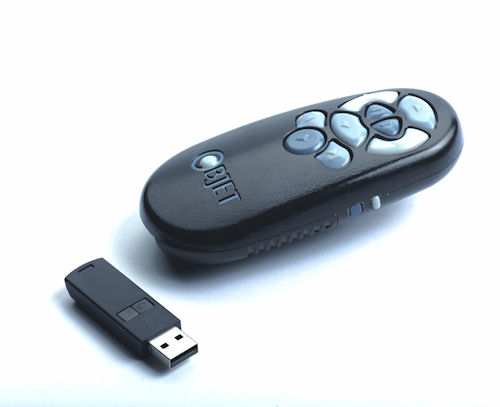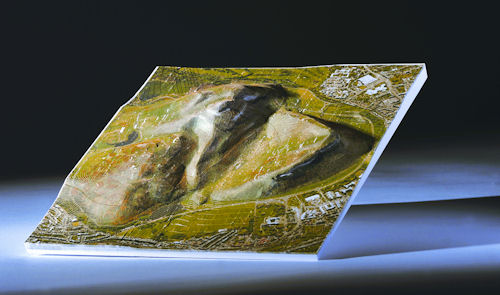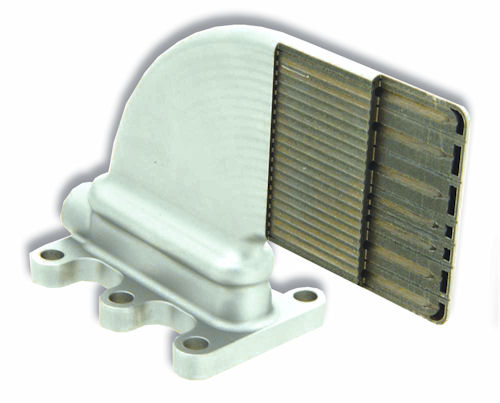3D Printing Materials
Paper or plastic ... or metal, wax, bio-cells?
November 1, 2012
By Pamela J. Waterman
Back in 1998, additive manufacturing (AM) industry consultant Terry Wohlers said, “New (AM) materials are being developed and commercialized regularly. Someday, they’ll have as many materials as Elton John has outfits.”
Wohlers’ comment targeted laser-sintering (LS) powders, but with the AM/3D-printing industry now well into its third decade, material options for all processes have indeed mushroomed into the hundreds. Whether your AM parts need color, flexibility, heat resistance, end-use durability or high precision, DE gives you a peek at the past year’s bumper crop.
Plastics and Wax
In the beginning, there was resin. It was clear, it was cured, and the parts produced with it on stereolithography (SLA) machines were pretty amazing “all things considered. Today, raw AM plastics and waxes come in a huge variety of liquids, powders, solids, phase-change materials and blends.
Leading the way with its “digital materials,” Objet Geometries announced 39 new ink-jet-based materials this year, bringing its total inventory to 107 variations on plastics. This number is based on the Objet Connex system’s ability to produce 90 composite blends on the fly by simultaneously jetting various amounts of two different primary materials. Properties offered by the 3D printing materials range from clear transparent to rigid opaque, and heat-resistant to polypropylene-like (for snap fits).
 |
| Models of a laser pointer and a GPS system built with “digital materials” (multiple materials, with different properties and colors, formed during a single build) on an Objet Connex AM system. Image courtesy Objet Geometries. |
Resins
Many AM customers want materials that mimic the properties of traditional production counterparts, but doing so with liquid resin systems has been a challenge. Now Envisiontec has announced two, possibly game-changing acrylonitrile butadiene (AB) resins that address that need: ABSflex and ABStuff, for use in the company’s Digital Light Processing (DLP)-based 3D printers.
“Our new AB resins have the true replication DNA of production-grade ABS,” says Al Siblani, Envisiontec CEO, adding that the material “offers long-term UV stability, is fully functional and does not lose any physical characteristics or incur material creep or degradation over time.”
The Envisiontec resins are aimed at creating rapid prototypes with mass-production quality on an economic timeframe.
3D Systems continues to develop new resins for its family of SLA systems. In early 2012, the company introduced Accura Sapphire Plastic, a low-ash burnout material targeted to highly detailed casting and master pattern applications such as jewelry. The new formulation, which replaces Accura Amethyst, contains no heavy metal contaminants, is more durable and displays slightly flexible behavior. That last feature allows designers to actually set gemstones into a master pattern, holding them in place during melt-out, so that gems are cast into place without manual handling.
A second SLA resin, 3D Systems’ CastPro, is designed for quick-cast processing where the part is dipped into a plaster then burned out, leaving a mold for casting. The material is dimensionally stable over days, making it suitable for creating multiple parts to assemble into large molds, without any swelling from moisture that previously led to tolerance issues.
The entire line of resin materials for the 3D Systems ProJet family has been upgraded and updated over the past 12 months. Buddy Byrum, 3D Systems’ vice president, product and channel management, explains how three different platforms are covered by the ProJet brand.
“The 1000 and 1500 Personal Printers use film-transfer imaging “the evolution of the VFlash DLP technology “and there are some significant differences in the way the system operates and materials are presented,” Byrum explains. “We developed a whole new range of liquid materials: the five color materials and the Zoom material, which was designed to build at a faster rate, building at over 0.8 in. in an hour.” The resulting polypropylene-like parts can be used for snap-fit applications.
The ProJet 3500/5000 professional printers employ multijet modeling (MJM) technology to create wax, acrylate or wax-acrylate blend parts.
At the high end, the 3D Systems ProJet 6000/7000 machines operate with “crossover” technology “a hybrid of SLA technology. These systems use a different set of VisiJet materials that are epoxy-based (laser-cured) liquids that do not undergo phase change. 3D System’s acquisition of the Huntsman RenShape material line led to the development of a new VisiJet Black ABS-like material “and in June, the VisiJet Clear Plastic material was Class VI (medically) certified.
 |
| 3D color-printed topological map showing the rock formation (the remains of a volcano) called “Arthur’s Seat” in Holyrood Park in the center of Edinburgh, Scotland. Created in full color from paper stock and proprietary inks on the new Matrix IRIS system from Mcor Technologies. Image courtesy Mcor Technologies. |
Powders
Supporting the LS world, CRP Technology of Modena, Italy, opened a US office in South Carolina, the de facto home of NASCAR racing. The expansion made sense, putting this materials-development company spot-on for some of its most demanding customers of end-use parts.
Recently, CRP Technology updated its Windform line of high-temperature, high-strength composite plastics to include GT (slightly flexible, incorporating polyamide fiberglass), XT 2.0 (carbon microfiber), and LX 2.0 (mineral fiber). Parts made from the latter two materials were featured in the June Le Mans invitational performance of the DeltaWing racecar. Just announced is Windform SP, a black composite-polyamide, carbon-filled material with waterproof properties and increased resistance to shock, vibration and deformation.
Advanced Laser Materials (ALM) markets and formulates more than 40 custom powdered plastics for LS systems. By blending nylons with additives such as aluminum, carbon fibers, hollow glass spheres and even copper (for heat-conductive molds), the company tailors materials to exhibit specific properties. Flow rate, heat deflection and z-direction adhesion are all affected by viscosity, filler content and particle size distribution. Neil Lehman, ALM vice president, marketing and commercial development, says the company’s latest materials are the glass-filled nylons PA 816-GS and PA 840-GSL.
Droplets/Extrusions
Row, Row Your AM Boat Not all progress comes from big-name companies. In a great thinking-outside-the-box story this summer, a University of Washington student club called the Washington Open Object Fabricators (WOOF) recycled, melted and extruded milk jugs into a 7-ft.-long boat, using a university custom 3D printer. The goal was to compete in the annual Milk Carton Derby in Green Lake, Seattle. Speaking to Phys.org, faculty adviser Mark Ganter, UW professor of mechanical engineering, said that printing a boat “was a historic first.” “Frankly, milk jug material is an awful material to work with,” Ganter said. “It shrinks, it curls, it doesn’t want to stick to itself. Overcoming all those parts of the problem was part of the achievement.” Not knowing how to handle this unexpected take on recycled cartons, contest judges decided to list the boat as an “unofficial entry in the adult open category;” it took second place in the race. “PJW |
For the 3D Systems ProJet 3500 and 5000 models, the wax, acrylate and wax-acrylate-blend VisiJet MJM materials are all considered “phase-change” materials “solid at room-temperature and liquid when heated for jetting. The jetted “dots” do not spread, and no UV curing is necessary, so the parts retain sharp features for modeling and casting. New plastics in the past year are VisiJet Crystal, Stoneplast, EX200 and MP200, all of which have Class VI medical certification.
In July, Solidscape, a Stratasys company, announced its 3ZMODEL organic build compound with wax-like properties and 3ZSUPPORT wax support. Both materials are stronger and more durable than their predecessors, and are targeted for use in the new Solidscape 3ZPRO one-touch printer (still based on the company’s drop-on-demand thermoplastic ink-jetting process). Solidscape says the advanced materials, primarily for jewelry and dental applications, produce no-ash/no-shrinkage wax patterns that are easier to work with, while retaining the precision and characteristics required for investment casting. 3ZMODEL offers a 50% strength improvement over previous generations. Both non-toxic materials come in color-coded and shaped solid “crayon” sticks for easy loading into the new printer.
Of course, all systems from parent company Stratasys build fused-deposition modeling (FDM) parts from extruded ABSplus plastic, but this year’s efforts have focused on offering new systems (such as the Mojo personal printer) and new partnerships. As an example of the latter activity, Stratasys is working with Oak Ridge National Laboratory to develop carbon-fiber reinforced FDM plastics to reduce commercial aircraft weight, and therefore fuel consumption; one project targets the design of an aircraft access-door.
Metals and Ceramics
The Ex One Co. is one of the early licensees of MIT’s 3D printing (ink-jet) process, adapting the technology for use with powdered metals and ceramics. Historically a rather low-key player, the company says it is now aggressively introducing new materials, and working on adding additional binder resins (besides its current furan) that will work with silica sand for cores and castings, including a phenolic and an inorganic binder. A new ceramic material will also be compatible with all three, and new metal materials are coming in support of the ExOne M-Flex printer.
“Customers need to be sure that the 3DP materials will compare favorably with parts that are machined or cast,” says Ex One CTO Rick Lucas. “Because of this, Ex One is establishing a new materials laboratory (Ex MaL) to be one of the premier 3D printing materials research, printing, processing and testing laboratories in the world.”
For parts made on EOS metal LS systems, besides the newer use of precious metals, some of the recent activity centers on the ability to create parts with variable porosity. For a knee replacement, adding a porous, base transitional structure (a tibial tray) aids in osseointegration, or bone ingrowth. Mechanically, large pores provide stress transfer, while small pores help with initial fixation; medically, the pores provide a large surface area that can be coated with a bioabsorbable bone-growth stimulant.
Morris Technologies, the largest service bureau of EOS systems, continues its work with pure and alloy versions of such metals as titanium, aluminum, stainless steel and the alloy cobalt-chrome (Co-Cr). It is developing copper alloys per customer requests. The heat transfer properties of copper alloys make them attractive; also near-net shape parts could be electrical discharge machined (EDMed) for electronics use. Another newer offering is Hastelloy X, a trademarked, nickel-based alloy known for its high-oxidation resistance.
A recent entrant in this industry, Viridis3D (co-founded in 2010), combines the expertise of original developers of processes at ZCorp (now a 3D Systems company) and Specific Surface (another of the MIT 3D-printer licensees). Viridis3D sells materials, 3D printing machines, software, scanners and training to help customers deploy functional 3D printed solutions for metal casting, ceramic applications and composites. They currently develop and market materials for sand-casting molds and cores as well as ceramic shells, including ViriShell alumina/silica ceramic, and have already spun off a custom ceramic manufacturing company called Figulo.
 |
| Internal cooling-channel detail on a metal part built on an EOS DMLS system. Image courtesy Morris Technologies. |
Paper/Organic Materials
Plastic Durability Comparison Perhaps the top question from prospective buyers is how durable AM-built end-use parts are. To shed light on the answer, Vista Technologies, a Minnesota service bureau operating Objet and Stratasys equipment, had an independent laboratory test and rank various properties of the eight most commonly requested materials, per their 2,000+ customers: SLS Duraform, SLS Duraform GF, SLA Accura60, SLA Accura Xtreme, FDM Polycarbonate, FDM ABS, Objet Vero White Plus and Objet Krypton Green. Results are posted online (Vistatek.com/Plastic_Prototype_Material_Test.html), and include parameters such as surface finish, soft durometer, heat deflection and tolerance. “PJW |
Full-color-printed paper now counts as an AM material, thanks to Mcor Technologies. The company continues to build on its low-cost, office-friendly systems (using ordinary copy paper and water-based adhesives) with the Mcor IRIS, a full-color 3D printing system that works on the same principle as the earlier Matrix 300. However, the IRIS system produces photorealistic parts by using specialized Mcor inks (at up to 600 dpi) to preprint the appropriate image-layer on each sheet of paper before it is fed into the build/trim chamber. At press time, Mcor Technologies expected to market the color system before the end of the year.
Touching on the realm of bio-printed materials, Envisiontec’s Bioplotter can fabricate scaffolds “for example, out of jetted soft hydrogels (such as collagen and alginate) for tissue engineering and controlled-drug-release structures, while Organovo’s Novogen MMX outputs patient-specific bioink spheroids onto a biopaper hydrogel to form each layer. In the latter process, when the object is complete, the biopaper slowly dissolves away and the bioink spheroids fuse together into living tissue.
Many other relevant bio-printed projects are also under way, such as the dynamic optical projection stereolithography (DOPsL) system at the University of California San Diego.
National News
The pilot institute of the National Additive Manufacturing Innovation Initiative (NAMII) in Youngstown, OH, is now official, under the direction of the National Center for Defense Manufacturing and Machining “and should really boost the development and understanding of AM materials. Members come from industry, research universities, workforce development groups, non-profits and professional associations. They will be focusing on applied research, bridging that critical gap between basic research and mature development work.
Clark Patterson is a special operations manager at service bureau Rapid Prototyping & Manufacturing, one of the industry members of the NAMII team. Regarding materials development, he says “AM metals have been done very well, but polymers are lacking in real development of commercial materials, especially where we have aerospace applications.”
Patterson says per discussions with NASA and other groups, his company is currently working on carbon-fiber/carbon-nanotube-reinforced materials “primarily for FDM use, because that technology is suited to accommodating long-fibers. Thermoplastic polyamides and PolyEtherEtherKetones (PEEKs) are attractive materials for more development due to the “Big 3” properties of strength, heat resistance and chemical resistance, though radiation shielding is another topic of interest.
Although material standards are still in their infancy (ASTM Subcommittee 42 received approval in January for its first material standard for powder-bed fusion of Ti6Al4V), that fact certainly hasn’t slowed material innovation. And, remember “this article has just touched on new developments; don’t forget about such awesome “old” materials as the LS thermoplastic powder TP 210 for creating rubber-like parts.
Soon the variety of materials will have Elton John asking for samples.
Contributing Editor Pamela Waterman, DE’s simulation expert, is an electrical engineer and freelance technical writer based in Arizona. You can send her e-mail to [email protected].
MORE INFO
National Additive Manufacturing Innovation Initiative
Rapid Prototyping & Manufacturing
For more information on this topic, visit rapidreadytech.com.
Subscribe to our FREE magazine, FREE email newsletters or both!
About the Author
Pamela Waterman worked as Digital Engineering’s contributing editor for two decades. Contact her via .(JavaScript must be enabled to view this email address).
Follow DE





